How Many Backlinks Do I Need To Rank On Page One?

Recent Posts
How many backlinks do I need to rank in SERPs? Everyone wants to rank #1 on Google, and backlinks are one of the secret weapons of high-ranking content–and quantity matters.
The problem is there’s too much conflicting, theoretical SEO information and not enough practical, proven methods. Finding good backlink strategies that work can feel like a lost cause.
With backlinks being one of the most important aspects of SEO, you need to know: how many backlinks will help you acquire the top spot?
There’s no magic formula that can tell us exactly how many backlinks your website needs to rank first. Instead, we can look at some adjustable variables to get an idea of what it takes.
Let’s explore how many backlinks your website needs to rank on page one, based on five key factors.
Factor #1: Homepage Brand Trust
If you frequently read SEOJet’s blog, then you understand the importance of building homepage brand trust.
What is homepage brand trust?
We define “brand trust” as the respect and loyalty customers have for your brand. It’s how they perceive you can deliver on your promises to them.
Applying this idea to the homepage, it’s your website’s ability to build instant trust with your visitors.
Homepages are the heart of your site, and doing homepage SEO the right way is the key to building a strong foundation that may get you on page one.
Without building proper brand trust on your homepage, the rest of your SEO efforts will be frustrating and extremely disappointing.
How many homepage backlinks should a website have to establish brand trust?
The way to gain brand trust is pretty simple: Build backlinks consistently to your homepage using branded anchors.
For example, if we wanted to build homepage brand trust for SEOJet, we could use the following branded anchors:
- SEOJet
- SEOJet.net
- SEOJet Backlink Software
- SEOJet Backlinks
The anchor refers to the clickable text in content that sends you to another website.
If you look at big brands (or websites that dominate the SERPs) you will find a common theme among all of them.
They all have a lot of links that point to their homepage, and 85%-95% of those links have one of the following as the anchor text: their brand name, their URL, or their URL written like “Website.com”.
In addition, they receive or build these links on a regular basis. This helps them stay relevant.
These are the signals to Google that a website is a legitimate brand.
So what does this have to do with getting to the number of backlinks you need to rank?
Pages that rank in Google’s top 10 separate themselves from the competition by really crushing homepage brand trust.
Beyond finding a “magic number” of backlinks, you need to pay attention to the type of backlinks you’re getting. The majority of your backlinks should contain branded anchor text.
As you start generating more backlinks, this ratio will be important in explaining why and how you’re ranking.
Factor #2: Your Website Niche
Some niches are more competitive than others, and competition matters when it comes to building backlinks. The more competitive the niche, the more backlinks you need to rank well.
The SEO niche, for instance, is full of expert practitioners who all know exactly how to rank at the top of Google. That makes the SEO niche one of the most (if not the most) difficult niches to try to rank in.
Other niches like florists or pet products are not as competitive.
Therefore, the number of backlinks needed for those websites will be vastly different from what you need to be on the top of the SEO niche.
Let’s do a quick comparison:
Let’s say you’re shopping for a raised pet bowl and type this same phrase into Google. Here are our results:
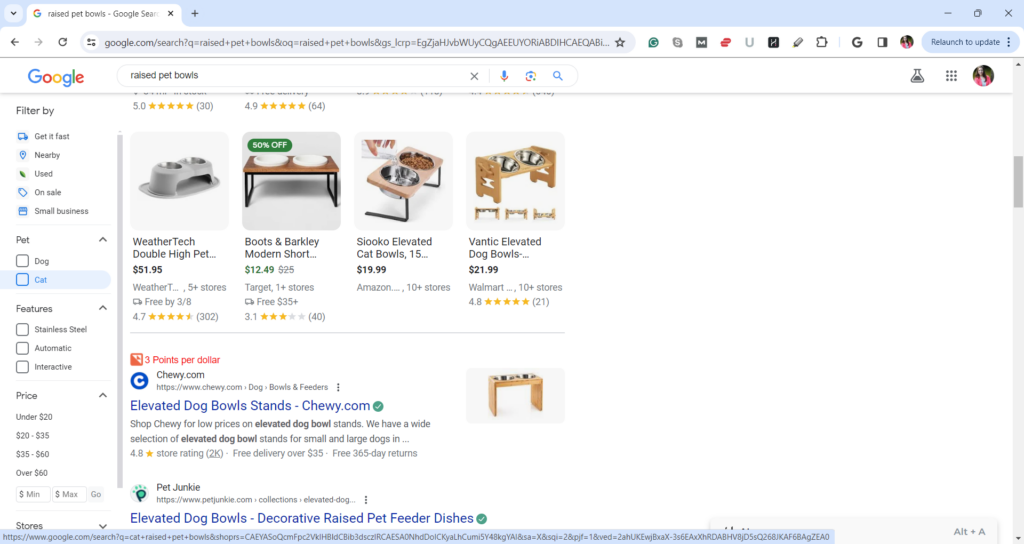
Chewy is a popular company, and according to UberSuggest, it has 149 backlinks to its page for elevated pet bowls.
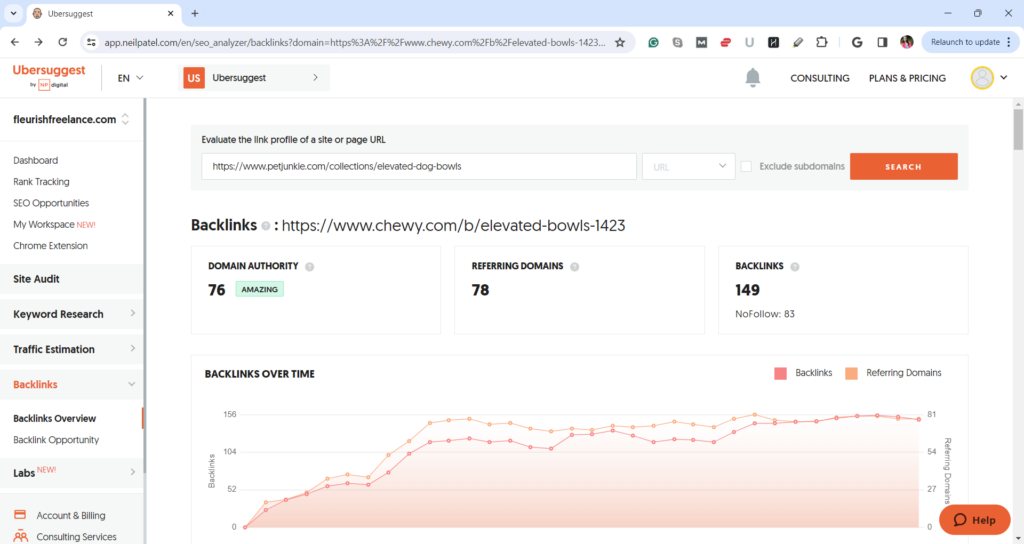
By comparison, the number two spot in this search is Pet Junkie, which has 17 backlinks to its elevate pet bowls page.
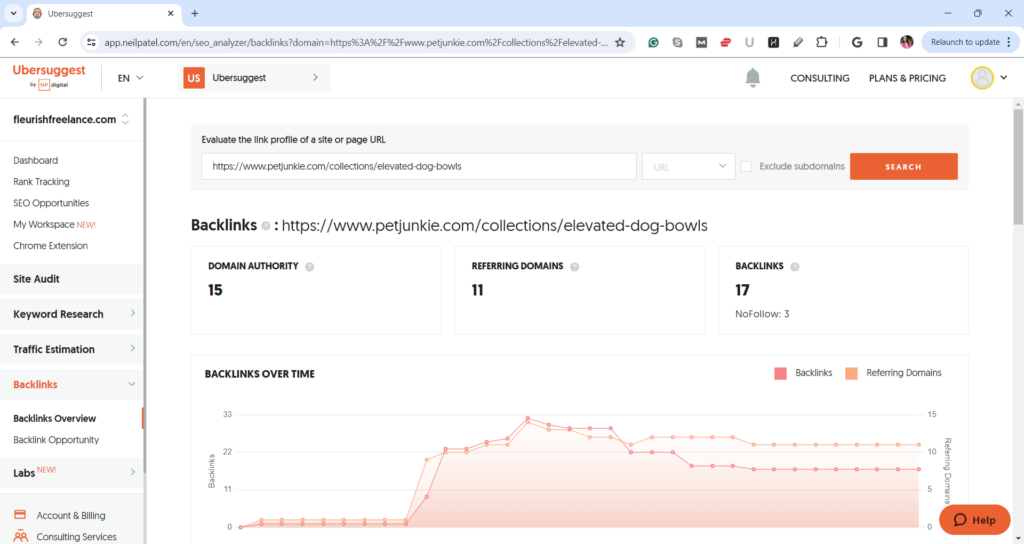
Now, let’s compare number of backlinks to a more competitive niche, like digital marketing.
Using Google to search for “What is SEO?”, we receive these results:
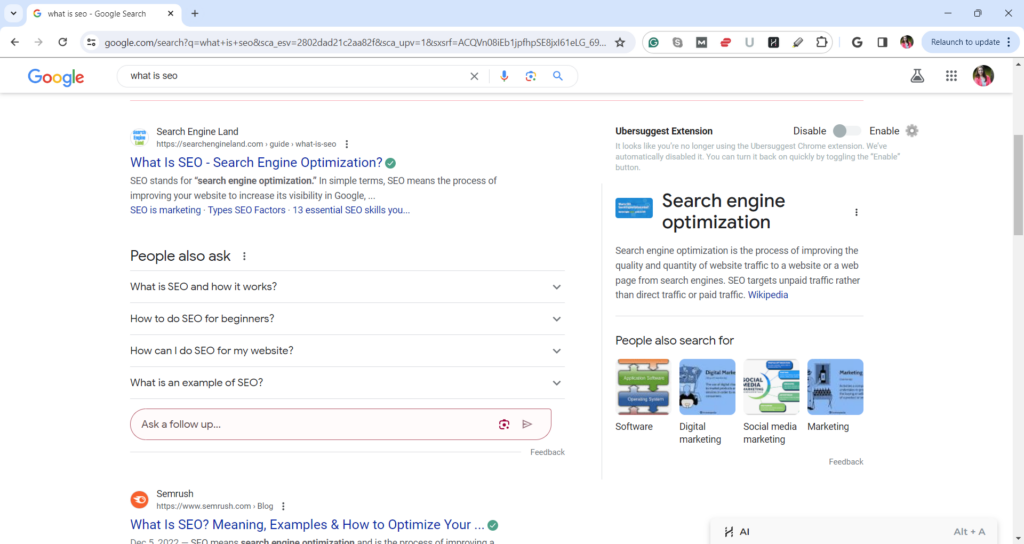
Looking at the first result from Search Engine Land, we see more than 195K backlinks!
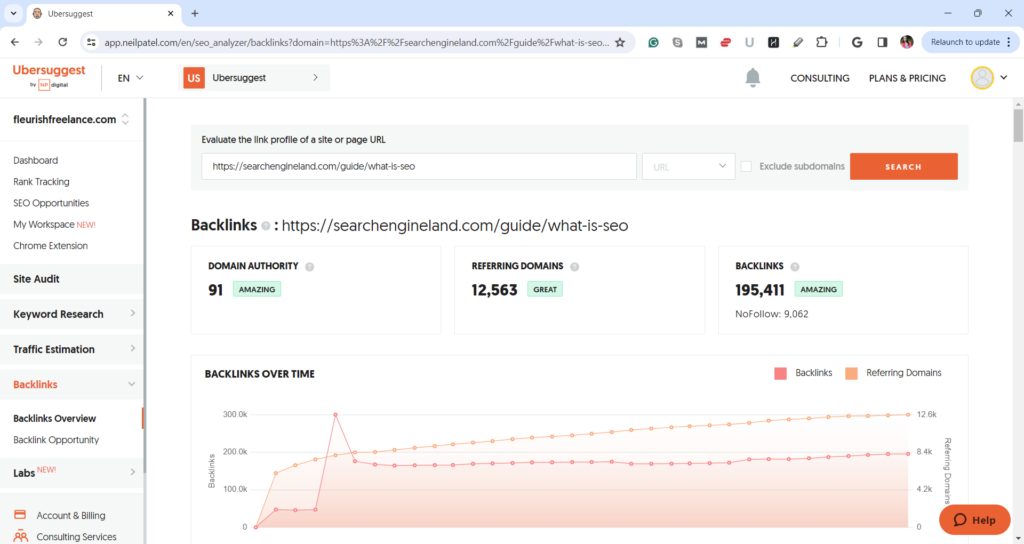
And the second result, from Semrush, shows 3,069 backlinks.
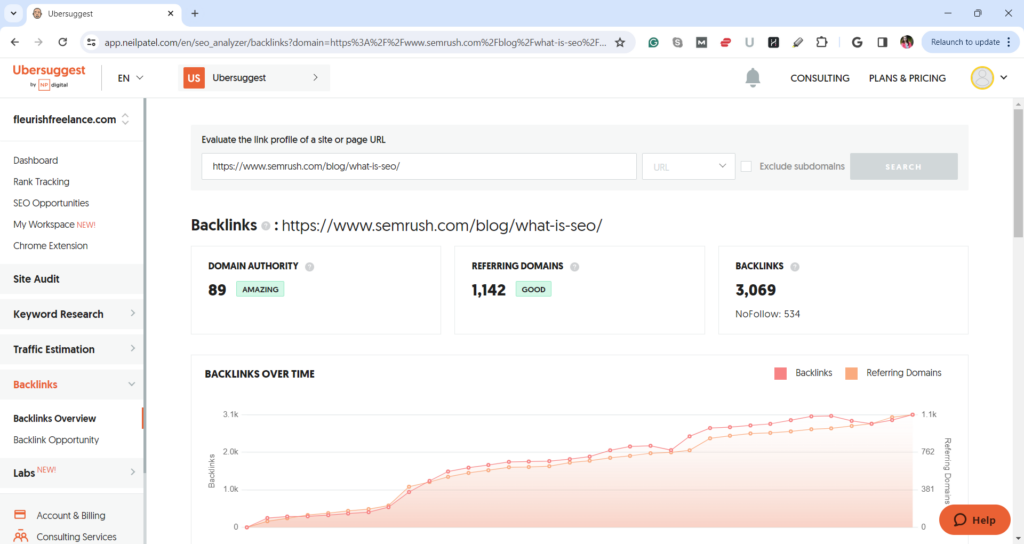
Take these examples as proof there is no magic number of backlinks to rank #1 on Google. Rather, the number of backlinks is one of many factors in a highly complex and constantly evolving algorithm.
If a business truly understands its niche and knows how competitive it is in terms of SEO, then it should have an idea of how many backlinks are needed. More competitive niches need more backlinks, plain and simple.
Factor #3: How Niche-Specific Is Your Website
One of the ways to get higher rankings with 70% fewer links than competitors is by building a website that is extremely niche-specific. This is a website that only covers one specific topic in-depth.
The logic here is that because you’re so focused on a single topic, you have fewer true competitors.
Fewer competitors make it easier to blaze a trail right up the SERPs.
For example, there is a difference between a general home improvement website and one specializing in plumbing.
If the plumbing website covers that niche with great pieces of useful content, it will be able to rank for plumbing-related key phrases better than a general home improvement website—even if you have fewer backlinks.
There is no limit to how niche a website can go. From the plumbing niche, you might get more specific by focusing only on hot water heaters, which will more easily rank for hot water heater-related key phrases.
Let’s see how this unfolds in the real world.
We searched for “How to descale a Keurig.” The first result came from Keurig itself, while the second result is from Good Housekeeping.
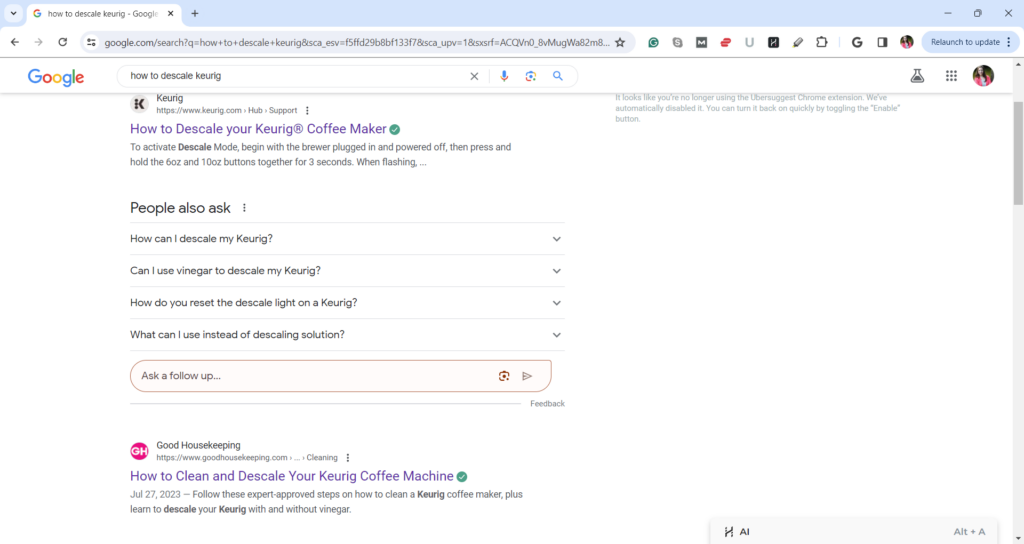
Keurig has a total of 442 backlinks:
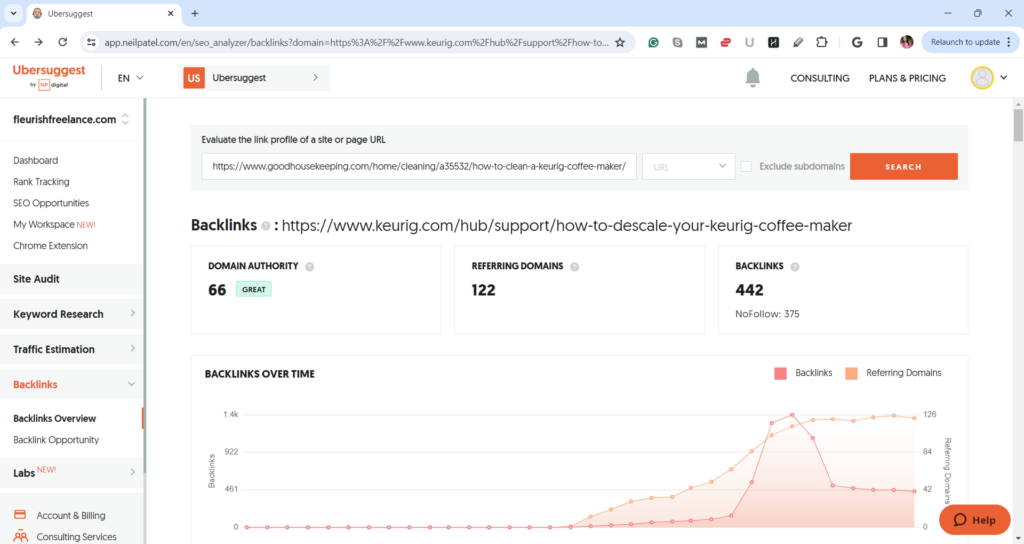
But Good Housekeeping had significantly more: 1,028 backlinks.
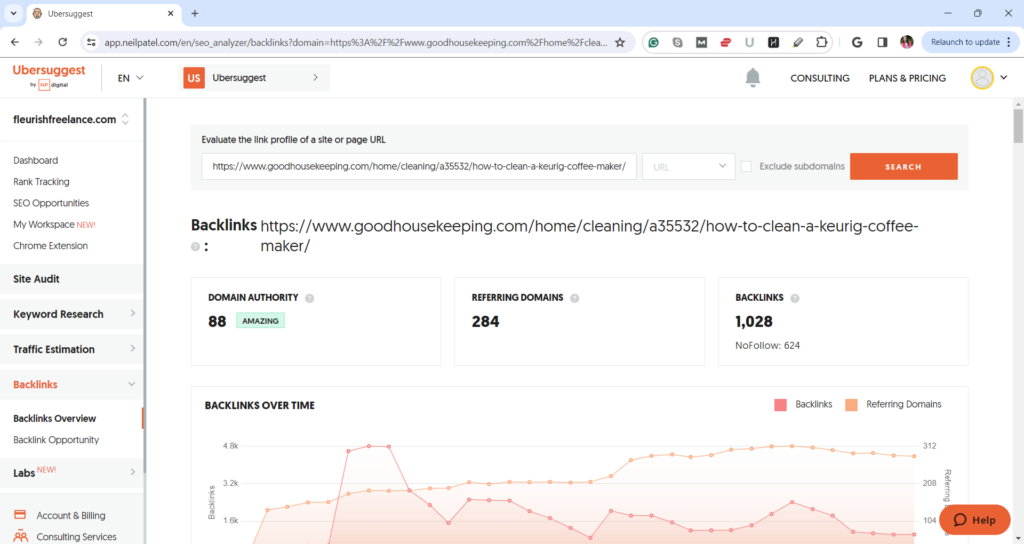
One reason for this is that Keurig is more niche-specific in this search. It knows Keurig coffee makers inside and out and is a better authority on how to clean them.
Good Housekeeping covers myriad home-related topics, including coffee maker care. But because it’s more general, it didn’t rank as high as a niche-specific website despite having more backlinks.
Google loves niche-specific sites that cover 100% of a single topic, and it shows in this example.
Factor #4: Is Your Page A Power Page Or Sub-Page?
Not all web pages are created equal. Most websites have a combination of “power pages” and sub-pages. The type of pages getting backlinks will have a lot to do with your rankings.
What is a power page?
A power page is a page on your site that is (mostly) non-promotional, is content-heavy (2,000+ words) with amazing content, and usually goes in-depth to solve a problem for your target audience. It’s your best content.
You might also call them pillar pages or long-form content.
What is a sub-page?
A sub-page is a lower-level website page that isn’t as heavy on content. They support your main pages and have a more specific purpose and focus.
These pages might be smaller pieces of a topic cluster or a product page linked to a larger category, for example.
Why is it important to differentiate between a regular sub-page on your website and a power page?
Backlinks need to look natural. Otherwise, it might look like you’re trying to manipulate search algorithms for the sake of ranking higher.
With power pages naturally having more content, then backlinks to those pages will appear more authentic.
A power page has enough content that it won’t look unnatural to build lots of backlinks to that page.
It wouldn’t look natural to have 100 backlinks pointing to your plumbing services page. Google will immediately know it’s manufactured. Don’t forget Google’s algorithms are seeking authentic and authoritative content.
On the other hand, a 3,000-word blog teaching you how to fix your own hot water heater could naturally have 100 backlinks.
Keep in mind that not every page falls in the power page category, so be mindful about the pages you choose to link to.
Businesses can still try to rank their sub-pages by building backlinks to the homepage and power pages first, and then internally linking to services pages from the power pages. This is a natural way to pass the SEO juice.
Factor #5: How Natural Is Your Backlink Profile
Not all backlinks are equal. Some will have your branded anchor text, like we previously discussed. Others might have generic, natural text like “click here” or “learn more.” And others might use specific keywords related to the page they’re linking to (this is SEO pixie dust, by the way.
Nearly all of your homepage links need to have branded anchors and all of your links should be from real websites (read: not garbage PBN’s).
But what about your power pages?
Some businesses want to rank for a particular key phrase so badly they can’t resist building a lot of exact match anchor backlinks.
But, this is a huge mistake.
In a #1 ranked backlink profile, Google expects to see less than 10% of backlinks be exact match anchors.
So what should the backlinks be?
Here’s what to include in a #1 ranking-worthy backlink profile
Your backlinks need to be a mixture of natural anchors, blended anchors, and exact match anchors.
This is sometimes out of your control if you’re obtaining organic backlinks.
But if you’re using a backlink-building service or software, you have more power over the anchor text you use and the pages you link to.
SEOJet backlink software can help you keep a natural backlink profile, regardless of what’s happening with your organic links.
Natural anchors are anchor texts that do not contain any key phrases. It would be things like:
- Your brand name,
- The full URL of the page you are linking to,
- Random phrases like “click here” or “this article”
Blended anchors are anchor texts that have all or part of your key phrase and then other words in the anchor as well.
For example, if your key phrase was “wedding rings,” a blended anchor might be “a good selection of wedding rings.”
Exact match anchors are when you use your key phrase by itself. In the wedding rings example, you’d use “wedding rings” as your anchor.
To make your profile look natural you need about 60% natural anchors, 35% blended anchors, and 5% exact match anchors.
(Note: as Google regularly changes its algorithm, this mix also changes.)
This is something you can track using SEOJet, as shown here:

Keep in mind that these percentages were created from taking the average of all #1 ranked pages across all industries.
SEOJet lets you choose to build out a link map to these percentages or take the average of all top 10 pages that rank for your main key phrase. This helps you see how competitors are using anchor text for the terms you want to rank for.

As you can see from the snapshot above, you can pick and choose which competitors in the top 10 you want to use to create the percentages for your gauges. That way, you can rule out popular (and unbeatable) sites like Wikipedia and Amazon.
This allows businesses to customize how they want to build backlinks and aggressively target those exact niches.
Enough Already—How Many Backlinks Do I Need?
Now that you have a solid understanding of the factors that cause Google to rank one website over another, we can better answer the question: How many backlinks do I need?
Again, keep in mind there isn’t a magic number. We proved this already in the examples above. But let us help you get closer to choosing your unique number.
Do I Really Need To Build Backlinks To My Homepage?
In order to create brand authority with Google, you have to build branded anchor backlinks to your homepage. Learning how to build brand trust with Google is a must-have for any strategy.
If you don’t get Google to recognize you as a legitimate brand, your pages won’t rank.
So, how many links will that take?
It really depends on your niche. But the truth is you should always be building backlinks to your homepage. As in, there’s no such thing as too many.
How Many Backlinks To Inner Pages?
Here’s the most effective way to find this answer quickly:
- Search Google for the key phrase you want to rank for.
- Look at everyone in the top 10.
- Plug those URLs into an SEO tool like Ubersuggest or Ahrefs to see how many backlinks they each have.
This process is a little complicated simply because it’s all manual and takes a lot of time to compare each URL. But doing this will give you an idea of how strong their brand authority is.
You want to look at the outliers in the top 10. If you notice one or two have significantly fewer backlinks but still made it into the top 10, you can start reverse engineering their backlink profile and other SEO factors that make them worthy of a top 10 placement.
Or, if you notice one has significantly more backlinks, this outlier skews the results and doesn’t represent an authentic backlink profile.
You might also ask and answer:
Which page has the least amount of backlinks?
Which page has the least amount of homepage links?
Who has the least combined?
Inside SEOJet, we have our “Competitors” tab that will show you the top 10 ranked pages for your main key phrase, along with how much content each page has, how many backlinks the page has, and the number of homepage links.
It then gives you averages of everyone on page one. Check it out below.

Let’s use the screenshot above to decide how many links it will take to rank for “backlink strategy.”
You can see that the total number of backlinks to each page that ranks in the top 10 ranges from zero all the way to 1,616.
The takeaway here is that backlinks only tell part of the story. SEO is more complicated than a backlink popularity contest, which we’ll dive into next.
Why doesn’t Google just automatically rank the page with the most backlinks as #1?
In the above example, there is a big outlier among the top 10 ranked sites. One of them has way more backlinks than the rest of the list. From Google’s perspective, this appears unnatural and they would expect to see each of the pages have a similar amount.
That’s why the site with 1,616 backlinks is ranking #5, not #1.
The biggest takeaway from this chart is how the minimum number of homepage links is over 300. Any businesses trying to make this list, therefore, would need to get at least that amount.
Is it possible to get there with fewer homepage links?
Sure it is. For example, a business would need at least 200 homepage links and at least 60-80 links pointing to that page.
Also keep in mind the numbers shown above are in the SEO niche, which you’ll remember is one of the most competitive.
Let’s look at another example outside of the SEO niche.

When studying the top 10 sites for “paleo meal plans,” it’s clear that the first five are stacked. It’s going to take a very aggressive backlinks strategy to break into that pack.

As you move down to 6-10 on the list, you have homepage backlinks as low as 190 and power page or sub-page backlinks as low as one. So the backlink numbers in the bottom five look much more manageable.

For this group, a business should expect to need around 200 homepage backlinks and 25-50 power page or sub-page backlinks to move into the bottom five on page one of Google.
As you can see from these charts, knowing what everyone else in the top 10 has done in terms of backlinks and content is extremely helpful in determining how many backlinks your website needs to rank on page one.
Using this strategy can also help you avoid spending a lot of time and money targeting key phrases that you don’t have a realistic chance to rank for on Google.
Let’s look at one more example in a much less competitive niche using a local search as an example. We’ll look at the key phrase “bed bug control Seattle.”

When you start dealing with local searches, the number of links you are going to need will drop considerably in most industries.
The first thing you do is ignore the outliers on this list. Yelp, Thumbtack, and the government website are the outliers and won’t be direct competitors if you have a pest control company.
Looking at the rest of the list you can see that some websites have as few as 22 homepage links. Most of the pages that actually rank have two or fewer backlinks.
For this site, a good target for backlinks would be 25-75 homepage backlinks and maybe 0-5 power page or sub-page backlinks.
The Sliding Scale Of Brand Authority, Content, And Backlinks
There are many reasons websites do or don’t rank. But, you can be successful with SEO if you master the right combination of the following three things:
- Building great brand trust on the homepage
- Creating content on power pages that crush competitors
- Building high-quality backlinks to that content
You may do well by only implementing one or two of these techniques.
Do a combination of all three and you’ll own the Google rankings.
Establishing Great Brand Authority
When a website has a ton of branded backlinks to their homepage, that brand trust is so well established that all of their pages rank well in Google—even with no backlinks or very few backlinks to their ranking page.

Yelp is a great example of a website that falls into this category. With over 90,000 homepage backlinks, Yelp has established brand authority and doesn’t need any links to other pages.
Their sub-pages also rank in the top three of Google for almost everything that is relevant to the page.
Other sites that fall into this category include Amazon, Overstock, Walmart, or Wikipedia.
If your business isn’t as big and powerful as Yelp! or Walmart, don’t panic! Remember, you only have to match or beat your direct niche competitors, not these enormous sites.
Create Content That Crushes Your Competitors
Once you have established homepage brand authority, you can focus on creating amazing content that will also help you rank in Google.
Creating a power page with content that is better than the other top 10 competitors can help you overcome any lack of backlinks.
Below is an example of a site that is in the top three for its main keyphrase. But, they have far fewer backlinks than everyone else in the top 10.

Look at the content on their page versus everyone else.
They have written a piece of content that is over 5,000 words long, while everyone else is in the 1,000-2,000 range. As a result, they can get away with 80-90% fewer homepage backlinks than those that rank around them.
They have positioned themselves as the authority on the topic by virtue of having far superior content than everyone else in the niche.
Google loves authoritative content.
Build High-Quality Backlinks To Content
Businesses need to be realistic when it comes to competing with others in the Top 10. It may not be financially possible for them to build more homepage backlinks or post more content than the others.
What they can do is beat them with high-quality backlinks to the page they want to be ranked.
What exactly is a high-quality backlink?
It’s a link that comes from an authoritative source, one that probably also does well in organic search rankings.
One ranking factor in SEO is a website’s Domain Authority, or DA. This rating is based on a scale from 1 to 100; the higher the DA, the more trustworthy, reputable, and authoritative the website.
These sites have low SPAM scores, probably have lots of backlinks of their own, and are well-established.
A backlink coming from a website with a high DA rating is like getting a recommendation from a trusted professional. The more high-quality backlinks you receive, the better your content looks to the algorithms.
Here is an example of a website that doesn’t have the best homepage brand trust in its niche. The site decided to write good content that matched its competitors and built more backlinks to their money page.

As you can see above, GotchSEO ranks #3 for the key phrase “build backlinks” and focuses on building high quantities of backlinks to the pages that they are trying to rank.
They also build enough homepage backlinks so Google will trust them as a brand.
GotchSEO has about 380 homepage backlinks. It may seem like a lot… until you look at data from the rest of the page one websites.

By comparison, the two websites above and below GotchSEO have on average 14,777 homepage backlinks, yet only 295 backlinks to the page that actually is ranking in Google.
GotchSEO had to build out a much higher quantity of backlinks to that page to make up for its lack of homepage backlinks.
Your backlink strategy should ultimately include these strategies to get one of your pages to rank:
- Brand trust
- Great content
- A ton of quality backlinks
Getting as many links as possible may sound like a winning strategy, but just remember that quality and relevance matter. Links from garbage sites are not going to help you.
How Many Backlinks Per Day Is Safe?
One of the biggest link-building myths out there is that Google will penalize businesses for building too many backlinks in one day. This is simply not true.
You can build as many links as you want each day, as long as the backlinks come from quality sites and your anchor text profile looks natural.
Let’s say you just published the most viral blog post ever on floral arrangements and everyone in the floral world decided to link to that blog post. Is that unnatural? Of course not.
But Google will expect that the anchor text profile will look a very specific way if it happens naturally. As in, you’ll have a mix of generic and keyword-specific anchor texts.
Something else to consider is that you can’t build a lot of backlinks to pages that shouldn’t get a lot of backlinks. We discussed this above with the plumbing website example. This is a big red flag and can penalize you, but not because of quantity alone.
Building backlinks to a homepage or power page is different. You can be more aggressive as long as the anchor profile looks good.
How Does SEOJet Help With Backlinks?
As you have seen in this article, the screenshots are inside of SEOJet’s backlink management software. So what is SEOJet?
SEOJet helps you become a backlink-building ninja.
The software looks at your current backlinks and shows you how natural it looks compared to other top 10 ranked pages. It also tells you what backlinks you’ll need next.

It takes all of the guesswork out of building backlinks for yourself or for your SEO clients.
The software helps you choose the right anchor text to make sure you get the most out of every backlink.
A built-in guest posting service can help obtain links from authority blogs that have real, organic traffic from Google.

SEOJet created a proprietary scoring system called “JetRank” to give a score to every single page you enter into the system. It will let you know how well the SEO and link building are going with each page and which pages you should focus on.

Give SEOJet A Try
Now that we’ve solved the mystery of how many backlinks it takes to rank on the first page of Google, it’s time to try our strategies for yourself.
The exact number varies based on your niche and other variables, including your homepage brand trust and the type of pages you’re trying to rank.
One thing we can guarantee is that SEOJet backlink management software takes the mystery out of what to do next. Within minutes, you can find out exactly what your competitors are doing to rank in the Top 10 on Google and build a strategy to match or surpass them.
The SEOJet team would love to teach you more about our software and demonstrate some of its more advanced features. All you have to do is schedule a call with us and we’ll go through everything with you!